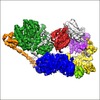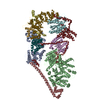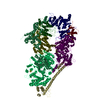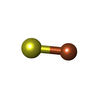+ Open data
Open data
- Basic information
Basic information
| Entry | Database: EMDB / ID: EMD-3802 | |||||||||
|---|---|---|---|---|---|---|---|---|---|---|
| Title | The cryo-EM structure of human TFIIH | |||||||||
 Map data Map data | Postprocessed (b-factor sharpened, low pass filtered) masked map used for atomic coordinate refinement. | |||||||||
 Sample Sample |
| |||||||||
| Function / homology |  Function and homology information Function and homology informationMMXD complex / core TFIIH complex portion of holo TFIIH complex / positive regulation of DNA helicase activity / negative regulation of DNA helicase activity / Cytosolic iron-sulfur cluster assembly / nucleotide-excision repair, DNA duplex unwinding /  central nervous system myelin formation / positive regulation of mitotic recombination / hair cell differentiation / central nervous system myelin formation / positive regulation of mitotic recombination / hair cell differentiation /  ventricular system development ...MMXD complex / core TFIIH complex portion of holo TFIIH complex / positive regulation of DNA helicase activity / negative regulation of DNA helicase activity / Cytosolic iron-sulfur cluster assembly / nucleotide-excision repair, DNA duplex unwinding / ventricular system development ...MMXD complex / core TFIIH complex portion of holo TFIIH complex / positive regulation of DNA helicase activity / negative regulation of DNA helicase activity / Cytosolic iron-sulfur cluster assembly / nucleotide-excision repair, DNA duplex unwinding /  central nervous system myelin formation / positive regulation of mitotic recombination / hair cell differentiation / central nervous system myelin formation / positive regulation of mitotic recombination / hair cell differentiation /  ventricular system development / hair follicle maturation / cyclin-dependent protein kinase activating kinase holoenzyme complex / nucleotide-excision repair factor 3 complex / nucleotide-excision repair, preincision complex assembly / ventricular system development / hair follicle maturation / cyclin-dependent protein kinase activating kinase holoenzyme complex / nucleotide-excision repair factor 3 complex / nucleotide-excision repair, preincision complex assembly /  UV protection / CAK-ERCC2 complex / transcription factor TFIIK complex / embryonic cleavage / 5'-3' DNA helicase activity / adult heart development / G protein-coupled receptor internalization / transcription factor TFIIH holo complex / transcription factor TFIIH core complex / cyclin-dependent protein serine/threonine kinase activator activity / 3'-5' DNA helicase activity / nuclear thyroid hormone receptor binding / UV protection / CAK-ERCC2 complex / transcription factor TFIIK complex / embryonic cleavage / 5'-3' DNA helicase activity / adult heart development / G protein-coupled receptor internalization / transcription factor TFIIH holo complex / transcription factor TFIIH core complex / cyclin-dependent protein serine/threonine kinase activator activity / 3'-5' DNA helicase activity / nuclear thyroid hormone receptor binding /  transcription preinitiation complex / RNA Polymerase I Transcription Termination / regulation of mitotic cell cycle phase transition / hematopoietic stem cell proliferation / RNA Pol II CTD phosphorylation and interaction with CE during HIV infection / RNA Pol II CTD phosphorylation and interaction with CE / spinal cord development / RNA polymerase II general transcription initiation factor activity / transcription factor TFIID complex / Formation of the Early Elongation Complex / Formation of the HIV-1 Early Elongation Complex / mRNA Capping / transcription preinitiation complex / RNA Polymerase I Transcription Termination / regulation of mitotic cell cycle phase transition / hematopoietic stem cell proliferation / RNA Pol II CTD phosphorylation and interaction with CE during HIV infection / RNA Pol II CTD phosphorylation and interaction with CE / spinal cord development / RNA polymerase II general transcription initiation factor activity / transcription factor TFIID complex / Formation of the Early Elongation Complex / Formation of the HIV-1 Early Elongation Complex / mRNA Capping /  bone mineralization / HIV Transcription Initiation / RNA Polymerase II HIV Promoter Escape / Transcription of the HIV genome / RNA Polymerase II Promoter Escape / RNA Polymerase II Transcription Pre-Initiation And Promoter Opening / RNA Polymerase II Transcription Initiation / RNA Polymerase II Transcription Initiation And Promoter Clearance / erythrocyte maturation / regulation of cyclin-dependent protein serine/threonine kinase activity / ATPase activator activity / regulation of G1/S transition of mitotic cell cycle / RNA Polymerase I Transcription Initiation / transcription elongation by RNA polymerase I / DNA topological change / intrinsic apoptotic signaling pathway by p53 class mediator / transcription-coupled nucleotide-excision repair / hematopoietic stem cell differentiation / Tat-mediated elongation of the HIV-1 transcript / Formation of HIV-1 elongation complex containing HIV-1 Tat / embryonic organ development / transcription by RNA polymerase I / Formation of HIV elongation complex in the absence of HIV Tat / Cyclin E associated events during G1/S transition / RNA Polymerase II Transcription Elongation / Cyclin A/B1/B2 associated events during G2/M transition / Formation of RNA Pol II elongation complex / maturation of SSU-rRNA from tricistronic rRNA transcript (SSU-rRNA, 5.8S rRNA, LSU-rRNA) / response to UV / Cyclin A:Cdk2-associated events at S phase entry / RNA Polymerase II Pre-transcription Events / bone mineralization / HIV Transcription Initiation / RNA Polymerase II HIV Promoter Escape / Transcription of the HIV genome / RNA Polymerase II Promoter Escape / RNA Polymerase II Transcription Pre-Initiation And Promoter Opening / RNA Polymerase II Transcription Initiation / RNA Polymerase II Transcription Initiation And Promoter Clearance / erythrocyte maturation / regulation of cyclin-dependent protein serine/threonine kinase activity / ATPase activator activity / regulation of G1/S transition of mitotic cell cycle / RNA Polymerase I Transcription Initiation / transcription elongation by RNA polymerase I / DNA topological change / intrinsic apoptotic signaling pathway by p53 class mediator / transcription-coupled nucleotide-excision repair / hematopoietic stem cell differentiation / Tat-mediated elongation of the HIV-1 transcript / Formation of HIV-1 elongation complex containing HIV-1 Tat / embryonic organ development / transcription by RNA polymerase I / Formation of HIV elongation complex in the absence of HIV Tat / Cyclin E associated events during G1/S transition / RNA Polymerase II Transcription Elongation / Cyclin A/B1/B2 associated events during G2/M transition / Formation of RNA Pol II elongation complex / maturation of SSU-rRNA from tricistronic rRNA transcript (SSU-rRNA, 5.8S rRNA, LSU-rRNA) / response to UV / Cyclin A:Cdk2-associated events at S phase entry / RNA Polymerase II Pre-transcription Events /  DNA helicase activity / hormone-mediated signaling pathway / extracellular matrix organization / post-embryonic development / insulin-like growth factor receptor signaling pathway / DNA helicase activity / hormone-mediated signaling pathway / extracellular matrix organization / post-embryonic development / insulin-like growth factor receptor signaling pathway /  chromosome segregation / determination of adult lifespan / promoter-specific chromatin binding / transcription elongation by RNA polymerase II / chromosome segregation / determination of adult lifespan / promoter-specific chromatin binding / transcription elongation by RNA polymerase II /  transcription initiation at RNA polymerase II promoter / nucleotide-excision repair / RNA Polymerase I Promoter Escape / TP53 Regulates Transcription of DNA Repair Genes / positive regulation of smooth muscle cell proliferation / G1/S transition of mitotic cell cycle / multicellular organism growth / cellular response to gamma radiation / NoRC negatively regulates rRNA expression / transcription initiation at RNA polymerase II promoter / nucleotide-excision repair / RNA Polymerase I Promoter Escape / TP53 Regulates Transcription of DNA Repair Genes / positive regulation of smooth muscle cell proliferation / G1/S transition of mitotic cell cycle / multicellular organism growth / cellular response to gamma radiation / NoRC negatively regulates rRNA expression /  protein localization / Dual Incision in GG-NER / Transcription-Coupled Nucleotide Excision Repair (TC-NER) / spindle / Formation of TC-NER Pre-Incision Complex / Formation of Incision Complex in GG-NER / Dual incision in TC-NER / response to calcium ion / Gap-filling DNA repair synthesis and ligation in TC-NER / Cyclin D associated events in G1 / protein-macromolecule adaptor activity / RUNX1 regulates transcription of genes involved in differentiation of HSCs / 4 iron, 4 sulfur cluster binding protein localization / Dual Incision in GG-NER / Transcription-Coupled Nucleotide Excision Repair (TC-NER) / spindle / Formation of TC-NER Pre-Incision Complex / Formation of Incision Complex in GG-NER / Dual incision in TC-NER / response to calcium ion / Gap-filling DNA repair synthesis and ligation in TC-NER / Cyclin D associated events in G1 / protein-macromolecule adaptor activity / RUNX1 regulates transcription of genes involved in differentiation of HSCs / 4 iron, 4 sulfur cluster bindingSimilarity search - Function | |||||||||
| Biological species |   Homo sapiens (human) / Homo sapiens (human) /   Human (human) Human (human) | |||||||||
| Method |  single particle reconstruction / single particle reconstruction /  cryo EM / Resolution: 4.4 Å cryo EM / Resolution: 4.4 Å | |||||||||
 Authors Authors | Greber BJ / Nguyen THD / Fang J / Afonine PV / Adams PD / Nogales E | |||||||||
| Funding support |  United States, 2 items United States, 2 items
| |||||||||
 Citation Citation |  Journal: Nature / Year: 2017 Journal: Nature / Year: 2017Title: The cryo-electron microscopy structure of human transcription factor IIH. Authors: Basil J Greber / Thi Hoang Duong Nguyen / Jie Fang / Pavel V Afonine / Paul D Adams / Eva Nogales /  Abstract: Human transcription factor IIH (TFIIH) is part of the general transcriptional machinery required by RNA polymerase II for the initiation of eukaryotic gene transcription. Composed of ten subunits ...Human transcription factor IIH (TFIIH) is part of the general transcriptional machinery required by RNA polymerase II for the initiation of eukaryotic gene transcription. Composed of ten subunits that add up to a molecular mass of about 500 kDa, TFIIH is also essential for nucleotide excision repair. The seven-subunit TFIIH core complex formed by XPB, XPD, p62, p52, p44, p34, and p8 is competent for DNA repair, while the CDK-activating kinase subcomplex, which includes the kinase activity of CDK7 as well as the cyclin H and MAT1 subunits, is additionally required for transcription initiation. Mutations in the TFIIH subunits XPB, XPD, and p8 lead to severe premature ageing and cancer propensity in the genetic diseases xeroderma pigmentosum, Cockayne syndrome, and trichothiodystrophy, highlighting the importance of TFIIH for cellular physiology. Here we present the cryo-electron microscopy structure of human TFIIH at 4.4 Å resolution. The structure reveals the molecular architecture of the TFIIH core complex, the detailed structures of its constituent XPB and XPD ATPases, and how the core and kinase subcomplexes of TFIIH are connected. Additionally, our structure provides insight into the conformational dynamics of TFIIH and the regulation of its activity. | |||||||||
| History |
|
- Structure visualization
Structure visualization
| Movie |
 Movie viewer Movie viewer |
|---|---|
| Structure viewer | EM map:  SurfView SurfView Molmil Molmil Jmol/JSmol Jmol/JSmol |
| Supplemental images |
- Downloads & links
Downloads & links
-EMDB archive
| Map data |  emd_3802.map.gz emd_3802.map.gz | 4.6 MB |  EMDB map data format EMDB map data format | |
|---|---|---|---|---|
| Header (meta data) |  emd-3802-v30.xml emd-3802-v30.xml emd-3802.xml emd-3802.xml | 36.8 KB 36.8 KB | Display Display |  EMDB header EMDB header |
| Images |  emd_3802.png emd_3802.png | 140.7 KB | ||
| Masks |  emd_3802_msk_1.map emd_3802_msk_1.map | 64 MB |  Mask map Mask map | |
| Others |  emd_3802_half_map_1.map.gz emd_3802_half_map_1.map.gz emd_3802_half_map_2.map.gz emd_3802_half_map_2.map.gz | 49.7 MB 49.7 MB | ||
| Archive directory |  http://ftp.pdbj.org/pub/emdb/structures/EMD-3802 http://ftp.pdbj.org/pub/emdb/structures/EMD-3802 ftp://ftp.pdbj.org/pub/emdb/structures/EMD-3802 ftp://ftp.pdbj.org/pub/emdb/structures/EMD-3802 | HTTPS FTP |
-Related structure data
| Related structure data |  5of4MC  6o9mM  8816C  8817C M: atomic model generated by this map C: citing same article ( |
|---|---|
| Similar structure data |
- Links
Links
| EMDB pages |  EMDB (EBI/PDBe) / EMDB (EBI/PDBe) /  EMDataResource EMDataResource |
|---|---|
| Related items in Molecule of the Month |
- Map
Map
| File |  Download / File: emd_3802.map.gz / Format: CCP4 / Size: 64 MB / Type: IMAGE STORED AS FLOATING POINT NUMBER (4 BYTES) Download / File: emd_3802.map.gz / Format: CCP4 / Size: 64 MB / Type: IMAGE STORED AS FLOATING POINT NUMBER (4 BYTES) | ||||||||||||||||||||||||||||||||||||||||||||||||||||||||||||
|---|---|---|---|---|---|---|---|---|---|---|---|---|---|---|---|---|---|---|---|---|---|---|---|---|---|---|---|---|---|---|---|---|---|---|---|---|---|---|---|---|---|---|---|---|---|---|---|---|---|---|---|---|---|---|---|---|---|---|---|---|---|
| Annotation | Postprocessed (b-factor sharpened, low pass filtered) masked map used for atomic coordinate refinement. | ||||||||||||||||||||||||||||||||||||||||||||||||||||||||||||
| Voxel size | X=Y=Z: 1.32 Å | ||||||||||||||||||||||||||||||||||||||||||||||||||||||||||||
| Density |
| ||||||||||||||||||||||||||||||||||||||||||||||||||||||||||||
| Symmetry | Space group: 1 | ||||||||||||||||||||||||||||||||||||||||||||||||||||||||||||
| Details | EMDB XML:
CCP4 map header:
| ||||||||||||||||||||||||||||||||||||||||||||||||||||||||||||
-Supplemental data
-Mask #1
| File |  emd_3802_msk_1.map emd_3802_msk_1.map | ||||||||||||
|---|---|---|---|---|---|---|---|---|---|---|---|---|---|
| Projections & Slices |
| ||||||||||||
| Density Histograms |
-Half map: None
| File | emd_3802_half_map_1.map | ||||||||||||
|---|---|---|---|---|---|---|---|---|---|---|---|---|---|
| Annotation | None | ||||||||||||
| Projections & Slices |
| ||||||||||||
| Density Histograms |
-Half map: None
| File | emd_3802_half_map_2.map | ||||||||||||
|---|---|---|---|---|---|---|---|---|---|---|---|---|---|
| Annotation | None | ||||||||||||
| Projections & Slices |
| ||||||||||||
| Density Histograms |
- Sample components
Sample components
+Entire : TFIIH
+Supramolecule #1: TFIIH
+Supramolecule #2: TFIIH core complex
+Supramolecule #3: TFIIH CDK-activating kinase (CAK) subcomplex
+Macromolecule #1: TFIIH basal transcription factor complex helicase XPB subunit,XPB...
+Macromolecule #2: TFIIH basal transcription factor complex helicase XPD subunit
+Macromolecule #3: General transcription factor IIH subunit 4,p52,General transcript...
+Macromolecule #4: General transcription factor IIH subunit 2
+Macromolecule #5: General transcription factor IIH subunit 3
+Macromolecule #6: General transcription factor IIH subunit 5
+Macromolecule #7: MAT1
+Macromolecule #8: Unassigned secondary structure elements.
+Macromolecule #9: Unassigned secondary structure elements (p52 region)
+Macromolecule #10: Unassigned secondary structure elements (XPB NTE region)
+Macromolecule #11: IRON/SULFUR CLUSTER
-Experimental details
-Structure determination
| Method |  cryo EM cryo EM |
|---|---|
 Processing Processing |  single particle reconstruction single particle reconstruction |
| Aggregation state | particle |
- Sample preparation
Sample preparation
| Concentration | 0.0049 mg/mL | ||||||||||||||||||||||||
|---|---|---|---|---|---|---|---|---|---|---|---|---|---|---|---|---|---|---|---|---|---|---|---|---|---|
| Buffer | pH: 7.8 Component:
| ||||||||||||||||||||||||
| Grid | Model: C-flat-4/2 / Material: COPPER / Mesh: 400 / Support film - #0 - Film type ID: 1 / Support film - #0 - Material: CARBON / Support film - #0 - topology: HOLEY / Support film - #1 - Film type ID: 2 / Support film - #1 - Material: CARBON / Support film - #1 - topology: CONTINUOUS / Pretreatment - Type: PLASMA CLEANING / Pretreatment - Atmosphere: AIR | ||||||||||||||||||||||||
| Vitrification | Cryogen name: ETHANE / Chamber humidity: 100 % / Chamber temperature: 278.15 K / Instrument: FEI VITROBOT MARK IV / Details: 3-4 minute incubation, 2 second blot. | ||||||||||||||||||||||||
| Details | Natively purified complex at approx. 10 nM concentration |
- Electron microscopy
Electron microscopy
| Microscope | FEI TITAN |
|---|---|
| Electron beam | Acceleration voltage: 300 kV / Electron source:  FIELD EMISSION GUN FIELD EMISSION GUN |
| Electron optics | C2 aperture diameter: 50.0 µm / Calibrated magnification: 37879 / Illumination mode: FLOOD BEAM / Imaging mode: BRIGHT FIELD Bright-field microscopy / Cs: 2.7 mm / Nominal defocus max: 4.5 µm / Nominal defocus min: 2.0 µm Bright-field microscopy / Cs: 2.7 mm / Nominal defocus max: 4.5 µm / Nominal defocus min: 2.0 µm |
| Sample stage | Specimen holder model: GATAN 626 SINGLE TILT LIQUID NITROGEN CRYO TRANSFER HOLDER Cooling holder cryogen: NITROGEN |
| Image recording | Film or detector model: GATAN K2 SUMMIT (4k x 4k) / Detector mode: COUNTING / Digitization - Dimensions - Width: 3840 pixel / Digitization - Dimensions - Height: 3710 pixel / Digitization - Sampling interval: 5.0 µm / Digitization - Frames/image: 1-30 / Number grids imaged: 4 / Number real images: 8300 / Average exposure time: 8.7 sec. / Average electron dose: 40.0 e/Å2 Details: 8300 micrographs collected in four session with identical acquisition settings. Sessions lasted 4, 2, 4, and 4 days and yielded 1200, 1700, 2800, and 2600 micrographs. |
- Image processing
Image processing
| Particle selection | Number selected: 1500000 Details: Initial rounds of particle selection using DogPicker within APPION to generate templates for subsequent RELION autopicking. |
|---|---|
| CTF correction | Software - Name: CTFFIND (ver. 4) / Software - details: run from within RELION Details: Correction in RELION based on values determined in CTFFIND4. |
| Startup model | Type of model: EMDB MAP EMDB ID: Details: Box and pixel size were adjusted before initial refinement. |
| Initial angle assignment | Type: PROJECTION MATCHING / Software - Name: RELION (ver. 1.4) Details: Maximum-likelihood 3D classification within RELION. |
| Final 3D classification | Software - Name: RELION (ver. 1.4) Details: Combination of individually sub-classified datasets (with variable number of classes). |
| Final angle assignment | Type: PROJECTION MATCHING / Software - Name: RELION (ver. 1.4) / Details: Maximum-likelihood 3D refinement within RELION. |
| Final reconstruction | Number classes used: 3 / Applied symmetry - Point group: C1 (asymmetric) / Algorithm: FOURIER SPACE / Resolution.type: BY AUTHOR / Resolution: 4.4 Å / Resolution method: FSC 0.143 CUT-OFF / Software - Name: RELION (ver. 1.4) / Details: RELION 3D auto-refinement (gold standard). / Number images used: 122900 |
| Details | Micrographs were inspected for quality of Thon rings and ice contamination. Poor micrographs were rejected. |
-Atomic model buiding 1
| Details | Initial model assembled from high-resolution structures and homology models. Subsequently rebuilt in O and COOT, refined into the cryo-EM map using PHENIX and REFMAC, and fully validated. |
|---|---|
| Refinement | Space: REAL / Protocol: RIGID BODY FIT |
| Output model |  PDB-5of4:  PDB-6o9m: |
 Movie
Movie Controller
Controller






























 Z
Z Y
Y X
X



























